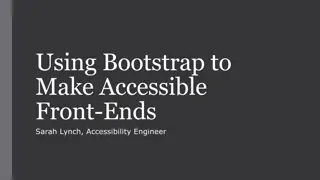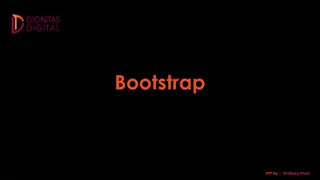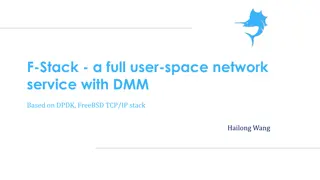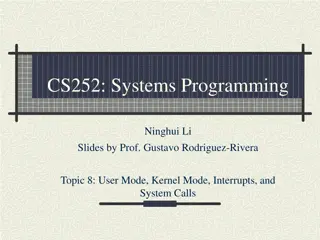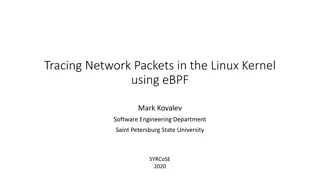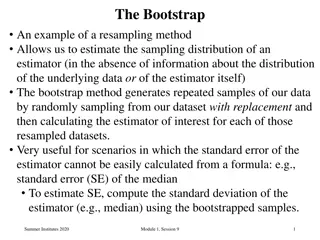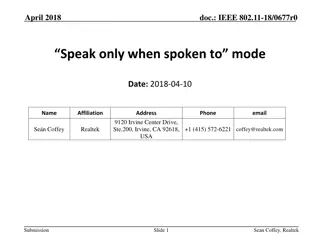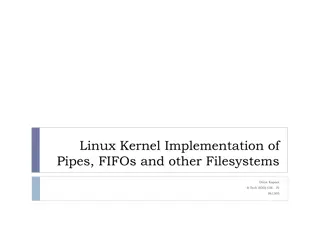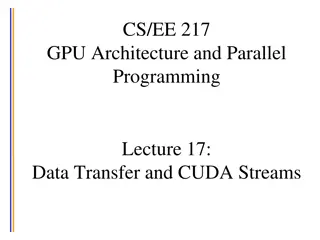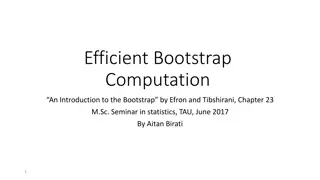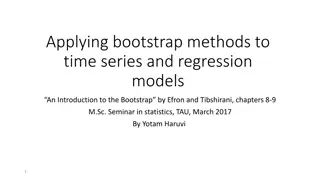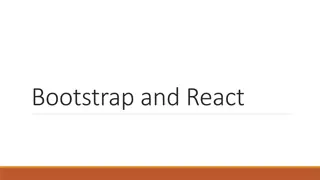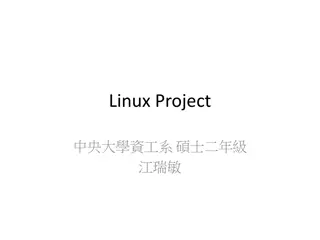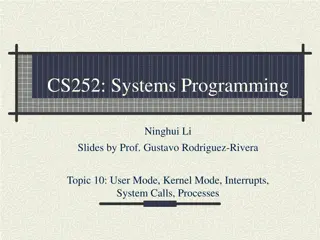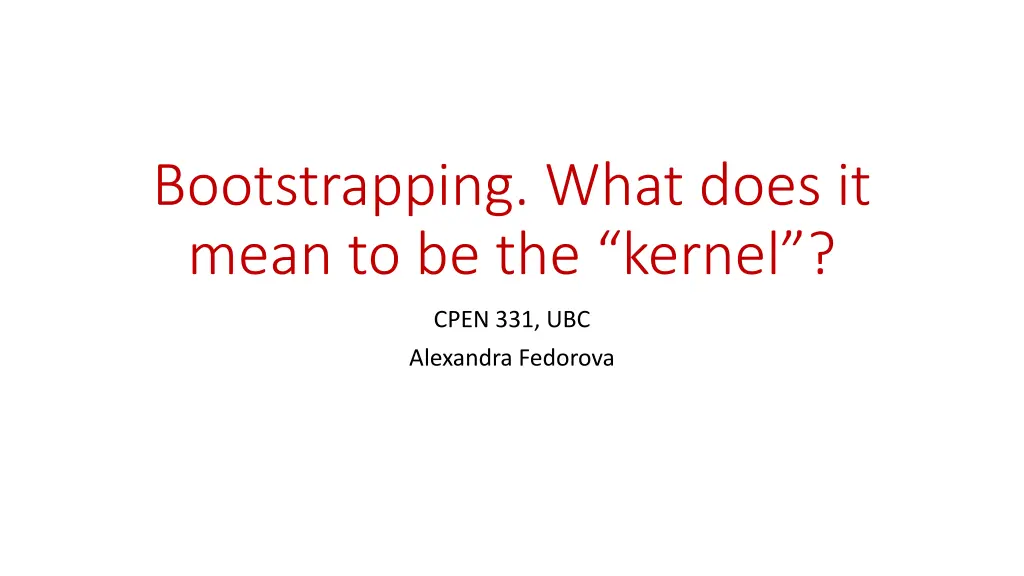
Understanding Bootstrapping and Kernel in CPEN 331 at UBC
Dive into the concept of bootstrapping and the role of the kernel in CPEN 331 at UBC led by Alexandra Fedorova. Explore the boot sequence exercise, group exercises, and key questions related to processor instructions, exception handlers, virtual memory, and memory mapping in the MIPS processor.
Download Presentation

Please find below an Image/Link to download the presentation.
The content on the website is provided AS IS for your information and personal use only. It may not be sold, licensed, or shared on other websites without obtaining consent from the author. If you encounter any issues during the download, it is possible that the publisher has removed the file from their server.
You are allowed to download the files provided on this website for personal or commercial use, subject to the condition that they are used lawfully. All files are the property of their respective owners.
The content on the website is provided AS IS for your information and personal use only. It may not be sold, licensed, or shared on other websites without obtaining consent from the author.
E N D
Presentation Transcript
Bootstrapping. What does it mean to be the kernel ? CPEN 331, UBC Alexandra Fedorova
The Boot Sequence Exercise The Boot Sequence Exercise Click on the link in the course calendar to find reading materials and to follow the exercise
Group (or individual) exercise Group (or individual) exercise Read the LAMEbus documentation and write down all hard-wired decisions, or expectations, that the hardware designers have made. For example, expecting that a processor begins execution at a certain address would be one of those hard-wired decisions.
Where does the processor expect to find the very Where does the processor expect to find the very first instruction to run, after it is powered on? first instruction to run, after it is powered on? A. 0x00000000 B. 0x80000000 C. 0xbfc00000 D. 0x1fe00000
At what virtual address must exception handlers be At what virtual address must exception handlers be placed placed after after we booted up we booted up that is, when the boot flag is no longer set? boot flag is no longer set? that is, when the A. 0x80000000 and 0x80000080 B. 0x80000200 C. 0xbfc00100 and 0xbfc00180
What is the maximum amount of virtual memory can be used by What is the maximum amount of virtual memory can be used by the user program running on the example MIPS processor? the user program running on the example MIPS processor? A. 4GB B. 2GB C. 1GB D. 508MB
Exercise: groups of 2 or individual Exercise: groups of 2 or individual Take a look at the physical and virtual memory maps in the LAMEbus documentation (linked off the Boot Sequence Exercise document) Draw a picture showing how virtual memory segments kseg0 and kseg1 map to the physical memory early in the boot sequence? Of all the segments that LAMEbus documentation mentions, map the ones for which you have the information Something like this: Virtual Some area of physical memory segment name
Discussion Discussion Why are some of the areas on the map are marked as not useful? Can you identify other not useful areas that are not marked?
How can one find out on the MIPS R3000 machine how How can one find out on the MIPS R3000 machine how much physical RAM there is? much physical RAM there is? A. It is hard-coded in the OS include file B. It is given as the argument to the OS when it boots C. One can read 4 bytes at the address 0x200 D. One can read 4 bytes at the address 0x?????200
What is the maximum number of CPUs What is the maximum number of CPUs supported by the MIPS R2000 architecture? supported by the MIPS R2000 architecture? A. 4 B. 16 C. 32 D. 64
How does How does kmain kmain() get called? () get called? A. In the binary it is aliased to __start. So the entrypoint found in the ELF executable will take us directly to kmain. B. The early bootstrap code in sys161 will copy exception handlers to where the processor expects them to be. Then it will jump to kmain.
At what virtual address is the kernel loaded? At what virtual address is the kernel loaded? A. 0x80000000 B. 0x80000200 C. Whatever the entry point in the binary D. 0x00000000 E. 0xbfc00000
How does How does ram_bootstrap ram_bootstrap() obtain the RAM size from the hardware? size from the hardware? () obtain the RAM A. It uses a special instruction. B. It reads from a special memory address. C. It sends an interrupt to the hardware. D. This value is hard-coded.
How does the OS get to run? How does the OS get to run? Let s look at a few options: Always on model A continuously running task that executes alongside user processes But then, who is going to context switch this task and user tasks? Alarm clock model It gets to run periodically when something happens e.g., a timer interrupt. But what if the user process needs a service between the timer interrupts? Client-server model The OS does not run until the user program explicitly invokes it. What if the user program never invokes it, usurps the hardware and never gets other programs to run?
How does the OS get to run? All of the above! How does the OS get to run? All of the above! Always on model NFS server a daemon that sits in the kernel and listens for incoming network requests Alarm clock model Upon a timer interrupt the kernel performs many housekeeping tasks: scheduling, page daemon, buffer daemon, etc. Client-server model The kernel runs when the user program invokes a system call.
Interrupts Interrupts It is what it sounds like The processor stops the normal execution loop And transfers the control (jumps) to a pre-defined code location This location is determined by the hardware The OS sets up some special code at that location known the interrupt handler The interrupt handler code determines the cause for the interrupt (it is recorded in special registers) And decides how to handle that particular interrupt
Example interrupts (or traps) Example interrupts (or traps) Timer interrupt I/O completion Segmentation fault Address translation fault
System calls System calls System calls are conceptually like function calls And yet they are notably different (on many operating systems) Source: The xv6 book
Why are system calls different from function Why are system calls different from function calls? calls? They don t have to be, but it is safer that way Imagine a scenario: A process calls a function in the kernel, because it wants some service from the kernel for example, to allocate more memory. It needs to be able to access kernel memory, e.g. update the virtual address space structures. What if the user code is malicious and decides to do something bad? E.g., steal a password from another process memory? Without protection, it could overwrite the kernel code to jump to another function (in its own code) and do what it wants. The OS must prevent this kind of behaviour!
System calls System calls offer protection offer protection a MIPS example a MIPS example To invoke a system call, execute a special instruction SYSCALL on MIPS This invokes a trap and transfers control to an interrupt handler (just like with interrupts!) Now, we are executing the kernel mode We run the OS code, which we supposedly trust The user process cannot simply overwrite this code before invoking the system call, it executes in the user mode, so hardware prevents it from accessing the kernel memory.
Now lets look at exception code in OS161! Now let s look at exception code in OS161! This exercise helps you answer code reading questions in Assignment 1 This exercise helps you answer code reading questions in Assignment 1 Hint: look at Hint: look at src/kern/arch/mips/locore/exception- mips1.S
Where is the first line of the OS161 code that is Where is the first line of the OS161 code that is executed when an exception (trap) occurs? executed when an exception (trap) occurs? A. The first line of mips_trap() B. The first line in the file exception-mips1.S C. The first line of the function mips_general_handler D. Depending on the exception, either mips_utlb_handler or mips_general_handler
Read the code in Read the code in mips_trap() and answer the following question: does it handle system calls and interrupts in the same question: does it handle system calls and interrupts in the same way or in different ways? way or in different ways? and answer the following A. YES B. NO C. It depends on the system call Hint: look at src/kern/arch/mips/locore/trap.c
to mips_trap() Does the exception code executed Does the exception code executed prior handle system calls and interrupts in the same way or in different handle system calls and interrupts in the same way or in different ways ways? ? prior to A. YES B. NO C. It depends on the system call Hint: look at src/kern/arch/mips/locore/exception-mips1.S
Other code walkthrough Other code walkthrough Trapframe Adding a new system call

